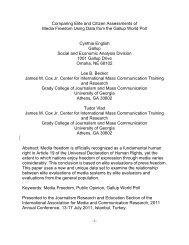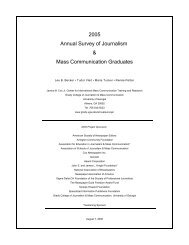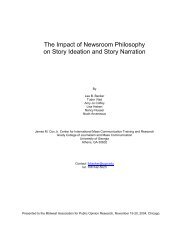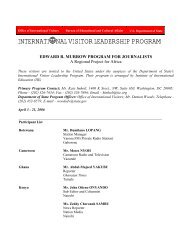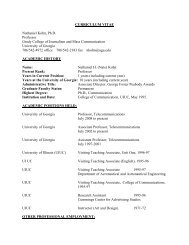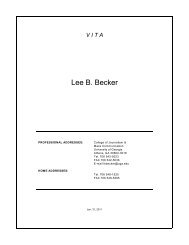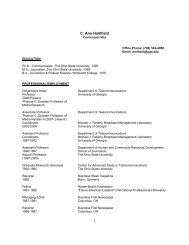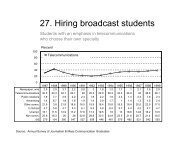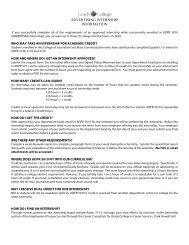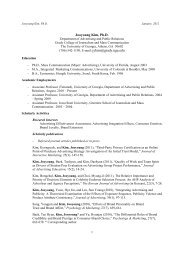Professionalism of News Workers - Grady College of Journalism and ...
Professionalism of News Workers - Grady College of Journalism and ...
Professionalism of News Workers - Grady College of Journalism and ...
You also want an ePaper? Increase the reach of your titles
YUMPU automatically turns print PDFs into web optimized ePapers that Google loves.
<strong>Pr<strong>of</strong>essionalism</strong> <strong>of</strong> <strong>News</strong> <strong>Workers</strong>: The Creation <strong>and</strong> Evolution <strong>of</strong> the Concept Page 24<br />
for the comparison <strong>of</strong> journalists with Hall’s sample <strong>of</strong> occupations in terms <strong>of</strong> their degree <strong>of</strong><br />
pr<strong>of</strong>essionalism. Leroy’s television sample was generally below Hall’s median rank.<br />
Haga, Graen <strong>and</strong> Dansereau (1974) drew on Hall to create measures <strong>of</strong> the pr<strong>of</strong>essionalism <strong>of</strong><br />
managers in a college housing <strong>and</strong> food service division. They found that highly pr<strong>of</strong>essional managers<br />
behaved quite differently from their low pr<strong>of</strong>essional counterparts. Specifically, the highly pr<strong>of</strong>essional<br />
managers worked harder <strong>and</strong> longer on tasks associated with their roles.<br />
Dyer (1977) also used Hall’s attitudinal approach in a study <strong>of</strong> social workers with bachelor’s<br />
degree to compare their pr<strong>of</strong>essional, bureaucratic <strong>and</strong> client service orientation with those <strong>of</strong> social<br />
workers trained by an agency. He found that the workers with a bachelor’s degree had a stronger<br />
tendency to accept pr<strong>of</strong>essional work norms than their agency-trained counterparts.<br />
More recently, studies <strong>of</strong> pr<strong>of</strong>essional workers such as lawyers <strong>and</strong> doctors have referenced<br />
Hall’s use <strong>of</strong> individual autonomy <strong>and</strong> self-regulation as important factors in job satisfaction <strong>and</strong><br />
pr<strong>of</strong>essional commitment. Wallace (1995) included autonomy as a variable in both job satisfaction <strong>and</strong><br />
organizational commitment in a study <strong>of</strong> lawyers working in 136 Canadian law firms. The findings<br />
suggested that corporatist control generally increases job satisfaction <strong>and</strong> organizational commitment for<br />
pr<strong>of</strong>essionals. H<strong>of</strong>f (2000) used Hall’s autonomy <strong>and</strong> self-regulation characteristics to represent<br />
pr<strong>of</strong>essional values in a survey measuring pr<strong>of</strong>essional commitment among physician executives in their<br />
roles as managed-care administrators. The findings showed that the pr<strong>of</strong>essional commitment <strong>of</strong> the<br />
physician executives was positively related to doing clinical work <strong>and</strong> that it helped them maintain their<br />
pr<strong>of</strong>essional identities.<br />
Only the study by Leroy (1972-73) in those reviewed above based on the Hall (1968) approach<br />
actually employed a st<strong>and</strong>ardized set <strong>of</strong> measures <strong>of</strong> pr<strong>of</strong>essional attitudes. The other studies rather are<br />
conceptually linked to Hall in that they employ the same reasoning about what pr<strong>of</strong>essional attitudes are.<br />
Over the years, a number <strong>of</strong> researchers in communication have modified the original McLeod<br />
<strong>and</strong> Hawley (1964) measures (Lattimore <strong>and</strong> Nayman,1974; <strong>and</strong> Nayman, Atkin, <strong>and</strong> O’Keefe,1973;<br />
Henningham,1984). One reason for the modification was the belief that McLeod <strong>and</strong> Hawley’s approach<br />
assumed journalists’ non-pr<strong>of</strong>essional traits were in some way “anti-pr<strong>of</strong>essional” (Henningham, 1984).



